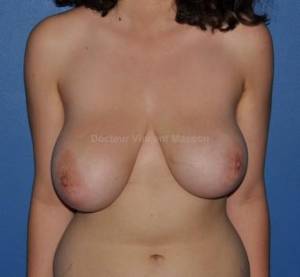Breast asymmetry

Breast asymmetry is a very common problem. In fact, statistically, and according to countless well-conducted scientific studies, almost no woman has breasts which are exactly the same.
One breast is always a little bigger, lower, more sagging, more forward, more pear-shaped or wider than the other. However, this asymmetry is generally very discreet, patients do not even notice it, and no aesthetic or functional awkwardness or embarrassment is felt.
In some cases, however, the breasts are clearly asymmetrical and a complex can develop which can range from an aesthetic complex all the way to a functional complex (difficulties in getting dressed for example). It is not uncommon for an aesthetic and functional complex to be associated.
A surgical intervention aimed at restoring symmetry to the breasts is most often possible (see the the prices for treatments by Dr. Masson, plastic surgeon in Paris).

Diagnosis of breast asymmetry
There are four components to take into account during the surgical correction of a breast asymmetry:
- The support on which the breast is positioned. Sometimes there is a malformation of the underlying skeleton (thorax, ribs, sternum). The breasts do not rest on the same base and an asymmetry appears.
- Breast volume. One breast is larger and the other smaller. The operation will aim to reduce one of the breasts (breast reduction) or to increase the other (breast augmentation), sometimes the two techniques are combined (breast reduction on one side and breast augmentation on the other).
- The shape of the breast. An empty, sagging, pear-shaped breast (breast ptosis) can, for example coexist with a firm, round breast. The shape should therefore be corrected.
- The areola and the nipple (what is called the nipple-areola-complex). An areola can be higher, lower, more internal or external, or of a larger size and shape. It will also be necessary to correct the asymmetry at the level of the areolae.

What are the causes of breast asymmetry?
Three origins are possible:
- Asymmetry is said to be idiopathic, that is, the cause is unknown.
- Traumatic origin. Asymmetry between the two breasts is caused by trauma or injury. Among the most common causes are the after-effects of burns, road accidents, skin cancer, breast cancer, vascular malformations and, sometimes, the after-effects of cosmetic surgery.
- Congenital origin. Present from birth but only visible during adolescence during breast development. Often the origin is malformative (e.g. the Poland syndrome or tuberous breasts). A family origin is possible.
Does the asymmetry disappear over time or after adolescence?
This is a frequently asked question by patients during consultations, the answer is unfortunately no, it is very unlikely or even impossible that a significant asymmetry will correct itself over time.

From what age can breast asymmetry develop?
From the end of adolescence, when the breasts have reached their final development.
Will health insurance cover breast asymmetry treatment?
Slight asymmetries are not covered by the health insurance system and fall under cosmetic surgery procedures. Major asymmetries with permanent bra compensation, malformation syndromes (high-grade tuberous breasts, Poland syndrome), breast enlargements weighing more than 300 grams and breast agenesis or severe hypoplasia below an A cup can be covered by health insurance.
What are the surgical techniques used for correcting breast asymmetry?
Each case is unique and it is not unusual for several surgical solutions to be used together.
Most often, both breasts are operated but sometimes the procedure involves only one.

The most common techniques are:
- Breast reduction, which makes it possible to lift the breast, reduce its volume, reshape it and reduce the size of the areola. The scars can be vertical or T-shaped.
- Ptosis correction which makes it possible to lift the breast, reshape it, and reduce the size of the areola. The volume is not affected.
- Ptosis correction with the fitting of an implant. The breast is raised, the shape modified, and the size of the areola can be reduced. The breast implant makes it especially possible to make the breast firmer, to create a more bulging clevage, to increase breast volume and to avoid a possible recurrence of ptosis (breast sagging). The scar is around the areola, vertical or T-shaped as appropriate.
- Lipomodelling (or lipofilling or fat transfer). Fat is removed by liposuction from another area of the body and reinjected into the breast to increase its volume. As a rule, the injected fat dissolves by 30%. The advantage of this technique compared to breast implants is that the result is definitive over time (except for large weight loss) and unlike implants does not require a future re-operation to change them.
- Breast augmentation by implant. An implant on one side or one on each side but of different sizes are fitted. Many techniques are possible and must be defined on a case by case basis; round, anatomical implants, in silicone gel, in front of, behind the muscle or in dual plane.
- Correction of asymmetry and position of the areolas.
In conclusion, each case is unique when dealing with breast asymmetry and many techniques are possible (for example: reduction on one side only, reduction on one side and increase by implant or lipomodelling on the other, increase on one side only, and one or several procedures. Many different cases are encountered). Only a personal consultation with Dr. Masson can define what can be done on a case-by-case basis.


